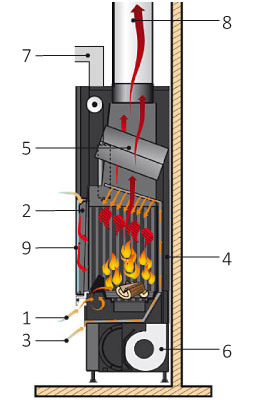OPERATING PRINCIPLE AND GENERAL SPECIFICATIONS
The devices are designed to produce hot air by burning wood.
Air from outdoors enters the gap between the combustion chamber and the stove's housing from below and is heated by contact with its hot walls before being delivered into the room.
Hot air is delivered to the room via a front-mounted grille and can also be sent to adjacent room via air ducts, thus heating the entire home uniformly.
The hot air is delivered either by convection or by a fan; if a fan is used, the stove must be fitted with a regulator to adjust the air speed in relation to its temperature.
The amount of combustion air, which may be primary, secondary (for cleaning the glass) or tertiary (post-combustion), is adjusted with shutters.
GENERAL OPERATIONAL SCHEME
For the scheme specific to your model, refer to the technical data sheet enclosed with the product.
 1 = primary combustion air intake (level with fire)
1 = primary combustion air intake (level with fire)
2 = secondary combustion air intake (enters at the top of the door, thus keeping the glass clean)
3 = tertiary post-combustion air intake, pre-calibrated (enters via a series of holes at the top of the combustion chamber)
4 = air heating gap
5 = heat exchanger for hot air production
6 = hot air fan complete with electronic controller
7 = hot air outlet ports for connection to air ducts; the air can be sent to the room in which the device is installed and/or to adjacent rooms, as desired
8 = fumes outlet port for connection to flue
9 = door with ceramic glass, resistant to thermal shock up to 800°

